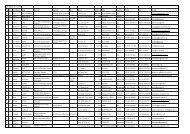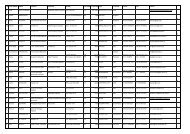icvg 2009 part I pp 1-131.pdf - Cornell University
icvg 2009 part I pp 1-131.pdf - Cornell University
icvg 2009 part I pp 1-131.pdf - Cornell University
Create successful ePaper yourself
Turn your PDF publications into a flip-book with our unique Google optimized e-Paper software.
— 19 —<br />
Likewise, an antibody binding strongly to GFLV and<br />
showing cross reactivity to ArMV was used for producing a<br />
single chain antibody fragment that was engineered into N.<br />
benthamiana plants. This antibody accumulated in the<br />
cytosol of transgenic plants, conferring <strong>part</strong>ial to complete<br />
protection against GFLV and a substantial tolerance to<br />
ArMV (Noelke et al., <strong>2009</strong>).<br />
Nicotiana benthamiana plants engineered with a<br />
construct expressing the coat protein of GLRaV-2, proved<br />
to be resistant to a fair proportion (up to 63% in T 2<br />
progenies) to infection by the transgene donor virus upon<br />
mechanical inoculation. Virus resistance in transgenic<br />
plants was consistently associated with a low level of<br />
transgene RNA transcript, suggesting post-transcriptional<br />
gene silencing. The successful introduction of GLRaV-2-<br />
derived resistance in a herbaceous host is regarded as the<br />
first step towards the possible control of GLRaV-2-induced<br />
disease in grapevines using this strategy (Ling et al., 2008).<br />
ADVANCES IN DIAGNOSIS<br />
Serology. New serological tools based on antisera<br />
raised in rabbits to recombinant viral proteins were<br />
produced in China and the USA for detection of GLRaV-2<br />
(Xu et al., 2006; Ling et al., 2007) and in Brazil for<br />
detection of GLRaV-2 and GVB (Radaelli et al., 2008). All<br />
antisera proved useful for virus identification in infected<br />
tissue samples.<br />
A single chain fragment variable antibody to GLRaV-<br />
3 originally synthesized for expression in planta to induce<br />
resistance, was expressed also in Escherichia coli and used<br />
to produce an ELISA kit. This antibody showed a weak<br />
cross reaction in ISEM assays with GLRaV-1<br />
(ampelovirus) and GLRaV-7 (unassigned species in the<br />
family Closteroviridae) but not with GLRaV-2<br />
(closterovirus). A fully recombinant and well-performing<br />
diagnostic kit was then developed with the inclusion of a<br />
recombinant GLRaV-3 CP protein expressed in bacteria.<br />
(Cogotzi et al., <strong>2009</strong>).<br />
Nucleic acid-based protocols. Improved protocols for<br />
the detection of nepoviruses belonging in different<br />
taxonomic subgroups were described in two papers. Digiaro<br />
et al. (2007) designed three sets of degenerate primers for<br />
each of the three Subgroups (A, B, and C) of the Nepovirus<br />
genus, based on the nucleotide sequence homology of the<br />
CP gene (RNA-2) and the untranslated region of RNA-1.<br />
These primers were able to detect simultaneously in RT-<br />
PCR all grapevine-infecting nepoviral species belonging to<br />
the same Subgroup and to discriminate species of different<br />
Subgroups.<br />
A similar a<strong>pp</strong>roach was followed by Wei & Clover<br />
(2008), who designed primers on the RdRp gene of<br />
Subgroup A and B nepoviruses. To increase sensitivity and<br />
specificity of detection a 12 bp non-complementary<br />
sequence was added to the 5’ termini of the forward, but<br />
not the reverse, primers.<br />
A higher detection level than that obtained by ELISA<br />
for the identification of Tomato ringspot virus (ToRSV) in<br />
grapevines, was achieved using a one-step SYBR green real<br />
time RT-PCR (Stewart et al., 2007). The same technique<br />
was successfully a<strong>pp</strong>lied in France for detecting variants in<br />
the four phylogenetic groups of GLRaV-2 known so far<br />
(Pinot noir, RG, 93/955, and BD) (see Beuve et al., 2007<br />
and references therein). Twenty samples from various<br />
French vineyards and 32 from Italy, Spain, Switzerland,<br />
Bulgaria, Turkey, Israel, South Africa and USA were<br />
examined and successfully identified with a RT-PCR assay<br />
in which a new set of universal primers was used, designed<br />
on the sequences of the highly conserved regions of p19<br />
and p24, in the 3’ end of the viral genome (Beuve et al.,<br />
2007).<br />
A gel-free, Rt-PCR-based fluorogenic detection<br />
method was developed for sensitive and quantitative<br />
detection of GLRaV-1 to GLRaV-5 and GLRaV-9. The<br />
range of the envisaged TaqMan® RT-PCR assay was broad<br />
and allowed the identification of virus isolates from 20<br />
different geographical regions, many of which could not be<br />
picked up by conventional RT-PCR (Osman et al., 2007).<br />
The tremendous diagnostic potentialities of TaqMan® RT-<br />
PCR protocols were confirmed by another study from<br />
California, that addressed the detection of viruses<br />
associated with the rugose wood complex (GVA, GVB,<br />
GVD and GRSPaV). These assays were conducted on 123<br />
vines from different geographical areas infected by one or<br />
more of the viruses taken into consideration. Results<br />
showed once more that TaqMan® RT-PCR was highly<br />
sensitive as it detected viruses fom purified RNA and crude<br />
tissue extracts at dilutions 32- and 256-fold higher,<br />
respectively, than conventional RT-PCR (Osman &<br />
Rowhani, 2008). A further improvement for the qualitative,<br />
sensitive and simultaneous detection of multiple viruses in<br />
the same sample came with a novel technology based on a<br />
modified real-time TaqMan® PCR, called TaqMan® lowdensity<br />
arrays (LDA). This technique was a<strong>pp</strong>lied for the<br />
first time to detection of plant viruses by Osman et al.<br />
(2008). Targets were 13 different grapevine viruses, i.e.<br />
GLRaV-1, -2, -3, -4, -5 and -9; GLRaV-2-RG, GRSPaV,<br />
GVA, GVB, GFLV, ToRSV and Grapevine fleck virus<br />
(GFkV) in grapevine accessions originating from Africa,<br />
Europe, Australia, Asia, Latin America and the United<br />
States. Of the three detection protocols compared,<br />
conventional RT-PCR, TaqMan® RR-PCR and LDA, the<br />
latter yielded the best results (Osman et al., 2008).<br />
A more classical a<strong>pp</strong>roach was used by Gambino &<br />
Gribaudo (2007) who developed a multiplex RT-PCR assay<br />
for the simultaneous detection of nine different viruses<br />
(ArMV, GFLV, GVA, GVB, GRSPaV, GFkV, GLRaV-1, -<br />
2 and -3), with coamplification of the 18S ribosomal RNA<br />
as internal control. Amplification with different sets of<br />
primers was from total RNAs extracted from 103 fieldgrown<br />
vines and in vitro grown plantlets from Italy,<br />
belonging to 38 cultivars.<br />
Particles of virus-transmitted nematodes are attached<br />
to the oesophageal lining of the vectors, thus their recovery<br />
requires disruption of the nematode cuticle by mechanical<br />
means. Martin et al. (<strong>2009</strong>) have developed a method<br />
whereby a commercial formulation of collagenase was used<br />
for dissolving the nematode cuticle, enabling viral RNA<br />
extraction from their bodies for subsequent amplification by<br />
RT-PCR. The procedure was successfully utilized for<br />
recovering genomic RNAs of ToRSV and Tobacco ringspot<br />
Progrès Agricole et Viticole, <strong>2009</strong>, Hors Série – Extended abstracts 16 th Meeting of ICVG, Dijon, France, 31 Aug – 4 Sept <strong>2009</strong>




